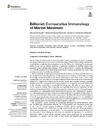Identificador persistente para citar o vincular este elemento:
https://accedacris.ulpgc.es/jspui/handle/10553/70039
| Campo DC | Valor | idioma |
|---|---|---|
| dc.contributor.author | Di Guardo, Giovanni | - |
| dc.contributor.author | Criscitiello, Michael Frederick | - |
| dc.contributor.author | Sierra Pulpillo, Eva María | - |
| dc.contributor.author | Mazzariol, Sandro | - |
| dc.date.accessioned | 2020-02-05T12:52:03Z | - |
| dc.date.accessioned | 2020-06-08T14:03:51Z | - |
| dc.date.available | 2020-02-05T12:52:03Z | - |
| dc.date.available | 2020-06-08T14:03:51Z | - |
| dc.date.issued | 2019 | - |
| dc.identifier.issn | 1664-3224 | - |
| dc.identifier.other | Scopus | - |
| dc.identifier.uri | https://accedacris.ulpgc.es/handle/10553/70039 | - |
| dc.description.abstract | Marine mammals rank among the most charismatic creatures inhabiting our planet. Yet despite their long evolutionary history, we have a limited knowledge of their biology, ecology, and behavior, including their morphofunctional adaptations to sea life. This is also frustrating for translational studies, as gas and fat embolic syndrome, a pathologic condition of Ziphiidae (deep-diving cetaceans), mimics decompression sickness (DCS) in human divers (1). Indeed, the development of a DCS-like condition in animals living exclusively in a marine environment for such a long evolutionary history was totally unpredictable! | - |
| dc.language | eng | - |
| dc.relation.ispartof | Frontiers in Immunology | - |
| dc.source | Frontiers In Immunology [ISSN 1664-3224], v. 10, (Octubre 2019) | - |
| dc.subject | 3105 Peces y fauna silvestre | - |
| dc.subject | 310903 Inmunología | - |
| dc.subject.other | Acquired Immunity | - |
| dc.subject.other | Cetaceans | - |
| dc.subject.other | Comparative Immunology | - |
| dc.subject.other | Host | - |
| dc.subject.other | Immunotoxic Contaminants | - |
| dc.subject.other | Innate Immunity | - |
| dc.subject.other | Marine Mammals | - |
| dc.subject.other | Pathogen Interaction | - |
| dc.subject.other | Pinnipeds | - |
| dc.title | Editorial: Comparative immunology of marine mammals | - |
| dc.type | info:eu-repo/semantics/article | - |
| dc.type | Article | - |
| dc.identifier.doi | 10.3389/fimmu.2019.02300 | - |
| dc.identifier.scopus | 85073230586 | - |
| dc.identifier.isi | 000496969300001 | - |
| dc.contributor.authorscopusid | 36860870100 | - |
| dc.contributor.authorscopusid | 6603909821 | - |
| dc.contributor.authorscopusid | 15742962600 | - |
| dc.contributor.authorscopusid | 24173815500 | - |
| dc.relation.volume | 10 | - |
| dc.investigacion | Ciencias de la Salud | - |
| dc.type2 | Comentario | - |
| dc.contributor.daisngid | 364862 | - |
| dc.contributor.daisngid | 29895782 | - |
| dc.contributor.daisngid | 30396242 | - |
| dc.contributor.daisngid | 888516 | - |
| dc.description.numberofpages | 3 | - |
| dc.utils.revision | Sí | - |
| dc.contributor.wosstandard | WOS:Di Guardo, G | - |
| dc.contributor.wosstandard | WOS:Criscitiello, MF | - |
| dc.contributor.wosstandard | WOS:Sierra, E | - |
| dc.contributor.wosstandard | WOS:Mazzariol, S | - |
| dc.date.coverdate | Octubre 2019 | - |
| dc.identifier.ulpgc | Sí | - |
| dc.contributor.buulpgc | BU-VET | - |
| dc.description.sjr | 2,116 | - |
| dc.description.jcr | 5,085 | - |
| dc.description.sjrq | Q1 | - |
| dc.description.jcrq | Q1 | - |
| dc.description.scie | SCIE | - |
| item.grantfulltext | open | - |
| item.fulltext | Con texto completo | - |
| crisitem.author.dept | GIR IUSA-ONEHEALTH 3: Histología y Patología Veterinaria y Forense (Terrestre y Marina) | - |
| crisitem.author.dept | IU de Sanidad Animal y Seguridad Alimentaria | - |
| crisitem.author.dept | Departamento de Morfología | - |
| crisitem.author.orcid | 0000-0003-3749-8845 | - |
| crisitem.author.parentorg | IU de Sanidad Animal y Seguridad Alimentaria | - |
| crisitem.author.fullName | Sierra Pulpillo, Eva María | - |
| Colección: | Comentario | |
Citas SCOPUSTM
6
actualizado el 08-jun-2025
Citas de WEB OF SCIENCETM
Citations
6
actualizado el 08-jun-2025
Visitas
110
actualizado el 01-mar-2025
Descargas
110
actualizado el 01-mar-2025
Google ScholarTM
Verifica
Altmetric
Comparte
Exporta metadatos
Los elementos en ULPGC accedaCRIS están protegidos por derechos de autor con todos los derechos reservados, a menos que se indique lo contrario.
